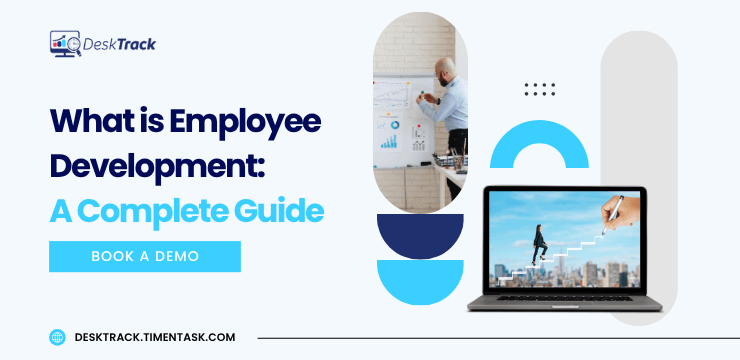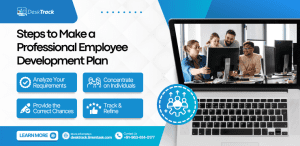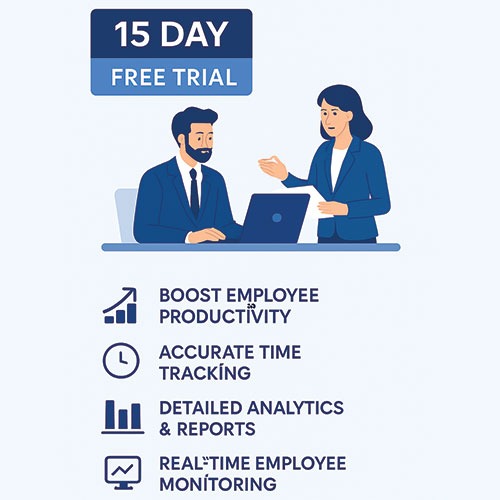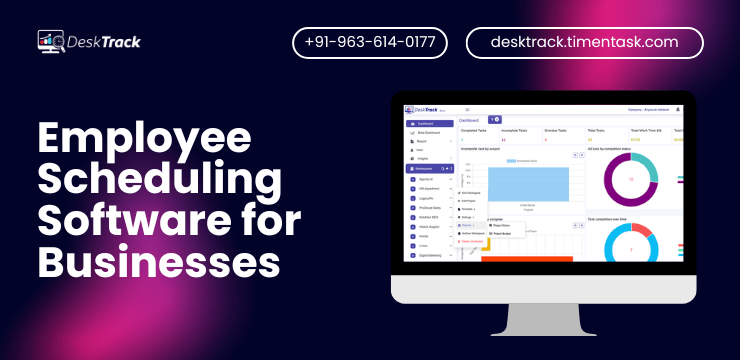
The right employee development plan paves your way to success and growth. When your teams are motivated enough to keep working and keep pushing through, everything you have planned will execute smoothly. The rest, including more employees, increased retention rates, and a higher client base, will follow one at a time. However, where do you start? We have covered everything you need in this blog.
An Overview of Employee Development

Let’s take a simple example, imagine you have started your car, and you are racing the engine. However, the car hasn’t moved an inch. You step down and identify that there are heavy ropes tied to the wheels. Development of employees is cutting through the ropes so that employees can put their skills and efforts (racing the accelerator) on the right path towards success and growth. Now, if your employees are showing no progress, even though they are giving their 100%, it is a signal that:
- They have reached the peak of their skills.
- Employees have no motivation and engagement.
- Employees are on the edge of burnout due to monotony, jealousy, and boredom.
Now, in our car example, you need at least two people. One to cut the rope and another to consistently press the accelerator. Otherwise, the car may go off on its own. Similarly, when you are developing your employees, you need to work together by assigning a leader. Now, to develop your employees properly for a better future, you also need to use strategies and understand individual needs for more chances of success.
Read Also: Top 10 Payroll Software for Small Businesses
Benefits of Employee Development

Investing more and more in your employees’ development yields many returns for both you, your employees, and your business, including:
1. Performance Enhancement
Just like our car won’t move, employees won’t progress towards a better future if there is no development either. When employees stay stuck at the same skill level for years, there is no ladder to climb on. Thus, with continuous development, there will be a step added simultaneously to the ladder for your employees to climb to the top.
2. Better Management
With the right skill development and experience, employees stay prepared for any unexpected situations. For example:
- Unexpected notices
- Unexpected client requests
- Unexpected discontinuals. I.e., the employee is ready to apply for a new job
3. Attract & Retain New Employees
A culture of growth and learning is what attracts new employees and retains your old ones, which ensures that you end up with a balanced workforce that can easily strive together to achieve success.
4. Reduce Expenses
As we mentioned before, when you develop your employees, the employee turnover rate decreases, which reduces expenses as you don’t have to hire new candidates for the same post frequently.
5. Helps Employees Grow
Every time your employee develops a new skill, they get a splendid chance to explore new markets, opportunities, promotions, and grow in their career. The only condition is that development is continuous and consistent.
6. Improve Employee Motivation & Engagement
When employees learn and grow in new skills and experience, they become more motivated and engaged in their work. It’s simple human psychology. Every time there is an opportunity, motivation and engagement follow. In short, interest in work. Overall, that’s the core of employee development.
7. Expansion, Innovation & Competitive Flexibility
When you have a balanced workforce of freshers and skilled individuals, this mix leads to the flexibility for expansion, innovation, and competition. That’s because in a mixed workforce, someone always brings new ideas, and there is always room for feedback and improvement.
Top 11 Proven Employee Development Methods for Your Business
Make your workday more productive
Time tracking and work management can help you reach your goals
faster.
So, now you know the benefits of developing your employees. However, how will you do it? We have 16 proven methods that worked for our employees:
- Training: This includes the regular training you provide to your employees. All you have to do is include skills, opportunities, and experience relevant to their jobs and the current market in the training program to get the desired outcome.
- Task/Job Rotations: This is one of the best ways to reduce the risk of burnout and boredom. What you are doing is giving your employees different tasks simultaneously in their schedules, or rotating their jobs, so that they also learn skills outside their niches.
- Coaching: Another way to develop your employees to achieve more growth and success is to coach them the right way. It’s the same as coaching students.
- Mentoring: Employees also need help along their way to success and growth. That’s where you need to act as a mentor and not a boss. That doesn’t mean that you are supposed to have no authority. You get the idea. Right?
- Workshops/Committees/Working Groups: Make the development of employees as practical as possible. One of the ways to do it is to arrange as many working groups, committees, and relevant workshops as possible without hindering the schedule.
- Simulations: This is suitable for more risky jobs, such as those of a pilot. So, for example, before the employee can fly the latest aeroplane, it’s better to simulate the flight technicalities first to get comfortable with how it works.
- On-the-Job Training: On-the-job training includes training employees while the job is still going on. This kind of employee development is on an urgent requirement basis.
- Individual Development Plans: In layman’s terms, it’s called personalized training. Since no employee is the same, they will progress at their own speed and convenience. Thus, IDPs help bring out and improve individual skills and talent in your organization.
- The 9-Box Grid: This grid specifies where your employees stand and their potential to improve. Data from this grid also helps make better IDPs for all your employees.
- Job Shadowing: Job shadowing means learning from others’ skills and experience by observing what and how they work.
- Develop Soft Skills: Soft skills, such as communication, are important for employees to, for example, convey their requirements, understand client needs, suggest ideas fluently, and with confidence.
Areas of Employee Development You Need to Work On
Other than knowing the employee development methods, it’s also essential to know where your employees need to develop.
- Flexibility: This is crucial for employee success and growth. An ideal employee needs to be flexible enough to adjust to any situation and organizational requirement.
- Communication Skills: Developing the communication skills of your employees is crucial for you to ensure that they are skilled enough to present your vision to clients and even skillfully convey their requirements.
- Conflict Resolution, Tactfulness & Work Ethic: This is a crucial skill to have, especially for leaders and managers. To get the right work done the right way, everyone needs to work as a team, apply the right work tactics, and follow work ethics like respecting everyone.
- Leadership Skills: For all those who have to take the role of a manager or leader, having good leadership skills is important to take their teams to success.
- Organizational Skills: Whether it’s their work, desk, or time, keeping everything arranged creates an atmosphere where everyone is relaxed enough to be able to work properly.
- Creativity Skills: These days, creativity is a requirement in all jobs, not just the creative work, such as designing or writing.
- Stress Management: Another important part of staff development is working on stress management. Of course, when you are in work life, there will be stress in one form or another. However, you can’t reflect it in your work output and quality. Developing employees to be good at work-life balance is a must.
Common Challenges in Employee Development Plans You Need to Overcome
Now you already know that you need to follow standard steps to make good employee development plans. However, why do you need these steps? These are the challenges you will face on your path to help your workers grow.
1. No Accountability
The first obstacle is no accountability. This issue can be on the employee side due to not taking training seriously or on the employer side, who is training your workers, for not scheduling a time to train teams, or simply ignoring requests. A lack of accountability also means that no one claims to be responsible if the training doesn’t yield the desired output.
2. No Talent Development Capabilities
If this is the case, then only the employer is to blame. This means that the one you have assigned to train and develop your employees is not capable enough to do so. Overall, it will only be a waste of everyone’s time.
3. Unaligned Employees & Business Strategy
Another challenge in employee development is that employees are not aligned with business strategies. In such cases, no matter how much your employees grow, your business will not move because the work output will never do anything to execute your business strategy. In short, everyone will just keep doing work without any reason.
4. Inconsistent Execution
The development of employees must be consistent. For instance, a workshop every other Friday. This ensures streamlined workflows and that the IDPs don’t hinder work. However, if you don’t plan and execute the training consistently, then it will lead to frustration, downgraded work quality, and burnout.
5. No Analytical Tools
If you keep developing your employees without employee monitoring software, you will not know if you are getting the right results, unless you individually analyze every employee (a time waster). In short, employee development without analytical tools is pointless.
6. Difficulty in Understanding Employee Requirements
As we mentioned before, understanding employee needs is crucial in making the right IDP. However, doing so is not easy at all because every employee has unique requirements. For example, an employee X might be good at their work but poor at communication skills. However, it is the opposite for worker Y. Understanding these individual needs is a tough job that needs dedication, precision, and time.
Read Also: A Complete Guide on Hierarchy Management System
Steps to Make a Professional Employee Development Plan

So, to overcome these challenges in the development of employees in your organization, you need a few standard steps. Here are the 4 simple steps that worked for us.
1. Analyze Your Requirements
First, you need to realize why you want to develop your employees. Evaluating your crucial requirements is the key to a good start. It ensures that you have a roadmap showing you where to go and how to get there.
2. Concentrate on Individuals
The smarter way for you is to make IDPs or individual development plans first. These include everyone’s requirements and carefully crafted documents that tell you how to train whom. These IDPs combined create your perfect employee development plan.
3. Provide the Correct Chances
Another smart tip is to provide the right opportunities to your employees. The idea is to help them grow in the direction they want to while also aligning their development, skills, and experience to successfully execute your business strategies.
4. Track & Refine
Sometimes, there might be fluctuations, such as employees not being able to reach their full potential. With tools such as time tracking software, you can track progress, identify obstacles, and steer it in the right direction by improving lags.
Clearly See the Employee Development Areas with DeskTrack
Employee development is not a simple task. Tracking and identifying everyone’s unique needs to create ideal IDPs and EDPs is crucial. With DeskTrack, this becomes easier with screenshot monitoring and behavior analytics tools. DeskTrack helps you see improvement and potential in real-time with detailed insights, app, URL, and file usage tracking. Spot your best employees and the ones who need improvement with data from the integrated project management tool. Grow your business forward with DeskTrack. Try now and realize why businesses in 100+ nations have implemented it.
Frequently Asked Questions (FAQ)
Q. What Do You Mean By Employee Development?
Ans. The development of employees involves identifying current skills and potential so that employees can put their skills and efforts on the right path towards success and growth.
Q. What is the Main Goal of Employee Development?
Ans. The primary goal of employee development is to align employee skills to the growing market needs and your business strategies. However, there are also many other benefits of developing your staff, including:
- Performance Enhancement
- Better Management
- Attract & Retain New Employees
- Reduce Expenses
- Helps Employees Grow
- Improve Employee Motivation & Engagement
- Expansion, Innovation & Competitive Flexibility
Q. What are the Common Challenges in Employee Development?
Ans. You will face these difficulties while developing the full potential of your workers.
- No Accountability
- No Talent Development Capabilities
- Unaligned Employees & Business Strategy
- Inconsistent Execution
- No Analytical Tools
- Difficulty in Understanding Employee Requirements
Q. What are the Four Stages of Staff Development?
Ans. The 4 stages of staff development are:
- Onboarding
- Performance
- Management
- Leadership
Q. What are Your Top 3 Areas of Development?
Ans. Developing yourself and your employees in these 7 areas is crucial for growth.
- Flexibility
- Communication Skills
- Conflict Resolution, Tactfulness & Work Ethic
- Leadership Skills
- Organizational Skills
- Creativity Skills
- Stress Management




